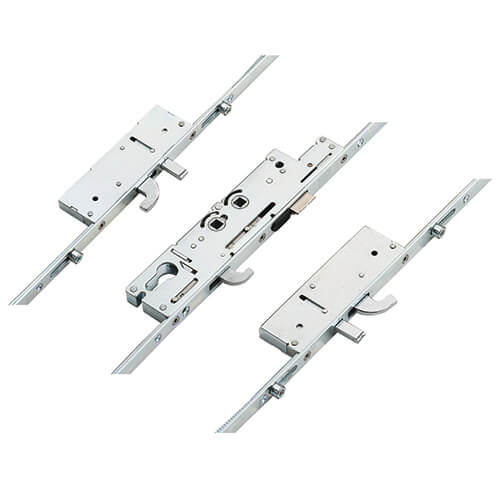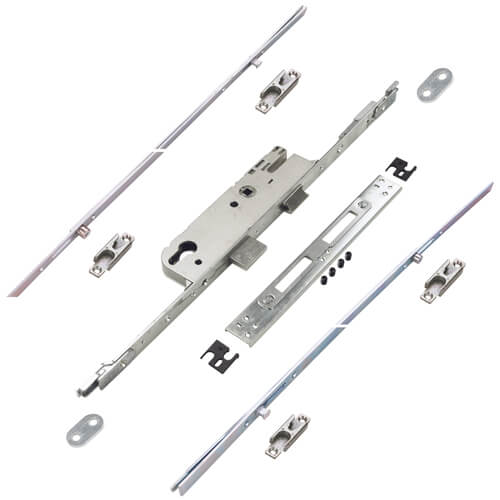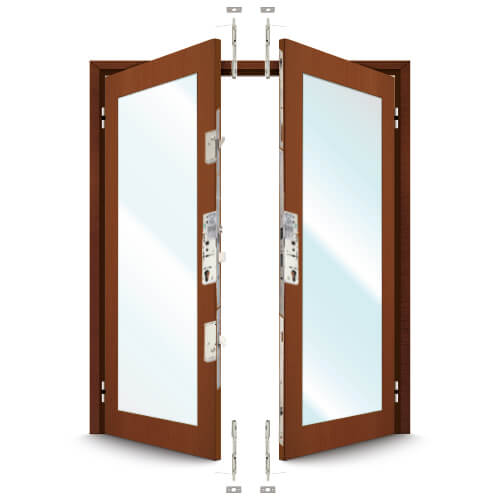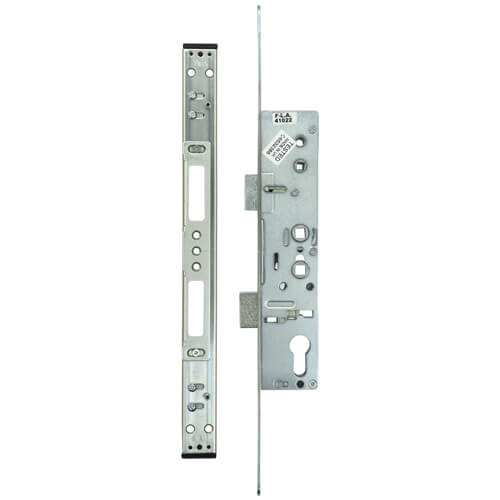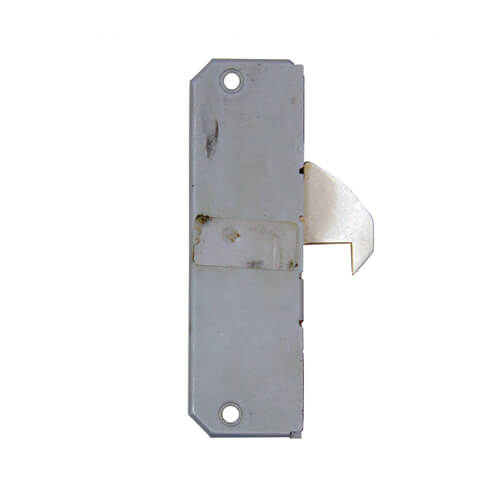Door Locks
Door Locks
Welcome to our UPVC Door Locks category, where we have the widest range of multipoint door locks available in the UK. We stock over 600 different multipoint door locks from top brands such as Winkhaus, GU, ERA, Yale, Lockmaster, Avocet, Fuhr, Fullex, KFV, and Millenco to provide you with the best range options for your job.
As well as our wide range of multipoint door locks we also stock a comprehensive range of replacement multipoint gearboxes, UPVC repair locks, and even electronic multipoint locks. Our extensive range means that we have a solution for every UPVC door, whether it be a standard residential door or a commercial door in a high-traffic area.
For those who need UPVC door locks quickly, we offer next-working-day delivery for orders placed before 7 pm. This means you can get the UPVC door lock you need to complete your job on time and keep your customers happy. Stock out overnight locks to make sure you can secure the property overnight in an emergency.
In addition to standard UPVC door locks, we also offer french door kits and timber and composite door kits. These kits are designed specifically for the type of door you are working on, ensuring that you have everything you need to install the lock correctly and efficiently. Whether you are installing a new door or replacing an existing lock, our kits have everything you need to get the job done.
We are confident that you will find the UPVC door lock you need in this category. With a range of top brands, next working day delivery, and a variety of options and kits, we have everything you need to keep your customers' properties secure. Browse our range today and see for yourself why we are the UK's leading supplier of UPVC door locks.
Multipoint Door Lock FAQs
Now you will commonly find a multipoint door lock on a UPVC plastic, composite and timber doors.
A multipoint door lock comprises of a centre gearbox with additional locking points running up the face of the door.
The Centre Gearbox
The gearbox is positioned at the centre of the faceplate and is where the operation of locking and unlocking is performed. Usually the gearbox will have a latch which retracts when a handle is operated, and a deadbolt which extends to lock the door as a key is turned or handle lifted. You may find some multipoint locks have a hook instead of a deadbolt.
The Faceplate
Faceplates come in varying widths and styles to suit different door profiles. Most common is a flat square ended faceplate but you can also get a radius rounded end or U-Track faceplate.
Additional Locking Points
There are a wide variety of different locking mechanisms all providing varying levels of security situated further up or down the faceplate away from the centre gearbox. Some multipoint door locks will only have 2 additional locking points whereas others will be classed as a higher level of security and can range up to 8 additional locking points. Commonly found types of additional locking points are:
- Rollers
- Mushrooms
- Hooks
- Deadbolts
- Pins
- Wedges
- Round bolts
As with most locks, multipoint door locks offer differing levels of security from one another. This level of security will depend on a few things like the number of additional locking points, what those locking points are (rollers, mushrooms, hooks, deadbolts, pins etc), the operation of the lock, and the level of security of the accompanying handles and cylinder.
Here’s a list of the additional locking points and extra features available on some models:
Locking Points
- Deadbolts
- Rollers (compression only not security)
- Mushrooms
- Offset Cam
- Sliders
- Pin Deadbolt
- Hook down
- Hook up
- Small Hook
- Down hook above Pin
- Up hook above pin
- AV2
- Hook and Deadbolts
- Round Bolts
- Poseidon
- Thunderbolt
Extra Features
- Shootbolts
- Entry Guard
- Lockout Facility
- Holiday Lock
Lift Lever Operation
To Lock - Lifting the door handles upwards causes all the additional locking points to engage. Turn the key in the cylinder to lock the door.
To Open – Turn the key in the cylinder to unlock mechanism. Push the handles downwards to disengage and retract the locking points.
Nightlatch Locking
To Lock – On closing the door, the latch is automatically engaged. Lift the door handle upwards to engage the locking points. Turn the key in the cylinder clockwise to lock the door. From the outside the latch cannot be retracted by the handle only by the key.
To Open – Turn the key in the cylinder to unlock the door. Push the handles downwards to disengage and retract the locking points. A turn of the key will then retract the latch.
Key Wind
To Lock – On closing the door, the latch is automatically engaged. Turn the key in the cylinder 2 full rotations to engage all locking points into position.
To Open – Turn the key in the cylinder 2 full rotations to retract the locking points. The final turn of the key will then retract the latch.
Fastlocking
To Lock - Lifting the door handles upwards causes all the locking points to engage and lock. There is no need to turn the key.
To Open – Turn the key in the cylinder to unlock the door. Push the handles downwards to retract the locking points. A turn of the key will also retract the latch.
Automatic locking
To Lock – Closing door causes all the locking points to engage. Turn the key to deadlock the mechanism.
To Open – Turn the key in the cylinder to unlock the door. Push the handles downwards to retract the locking points. A turn of the key will also retract the latch.
Common signs that your multipoint door lock is faulty
- The door handle drops or feels loose.
- The locking points no longer engage or retract fully and show signs of wear.
- The door handle is stiff, makes a grinding noise or you need to use excessive force to pull the lever down.
- You need to use excessive force when turning the key to operate the deadbolt/hook.
- One or more of the locking points fail to operate all together when you operate the handle.
AGB multipoint door locks
Avantis multipoint door locks
Avocet multipoint door locks
Azbe multipoint door locks
Cego multipoint door locks
Elite multipoint door locks
ERA multipoint door locks
Fab n Fix multipoint door locks
Fix multipoint door locks
Fix Asgard multipoint door locks
Fuhr multipoint door locks
Fullex multipoint door locks
Gridlock multipoint door locks
GU multipoint door locks
GU Ferco multipoint door locks
Ingenious multipoint door locks
Kenrick multipoint door locks
KFV multipoint door locks
Lockmaster multipoint door locks
Maco multipoint door locks
Mila multipoint door locks
Millenco multipoint door locks
Roto multipoint door locks
Safeware multipoint door locks
Securistyle multipoint door locks
Sobinco multipoint door locks
Ucem multipoint door locks
Union multipoint door locks
Vitawin multipoint door locks
Wilka multipoint door locks
Winkhaus multipoint door locks
Yale multipoint door locks
Multipoint door locks for timber doors
Avantis multipoint locks for timber doors
Avocet multipoint locks for timber doors
Elite multipoint locks for timber doors
ERA multipoint locks for timber doors
Fuhr multipoint locks for timber doors
Fullex multipoint locks for timber doors
GU multipoint locks for timber doors
GU Ferco multipoint locks for timber doors
Lockmaster multipoint locks for timber doors
Maco multipoint locks for timber doors
Millenco multipoint locks for timber doors
Sobinco multipoint locks for timber doors
Winkhaus multipoint locks for timber doors
Yale multipoint locks for timber doors
Multipoint door locks for French doors
ERA Multipoint door locks for French doors
Multipoint Door Slave locks
Avantis Multipoint door slave locks
Elite Multipoint door slave locks
ERA Multipoint door slave locks
Fuhr Multipoint door slave locks
Fullex Multipoint door slave locks
GU Ferco Multipoint door slave locks
KFV Multipoint door slave locks
Lockmaster Multipoint door slave locks
Maco Multipoint door slave locks
Mila Multipoint door slave locks
Millenco Multipoint door slave locks
Roto Multipoint door slave locks
Winkhaus Multipoint door slave locks
Yale Multipoint door slave locks
Multipoint door locks for stable doors
KFV Multipoint Door Lock for Stable Doors
Fuhr Multipoint Door Lock for Stable Doors
Multipoint door lock operations
Lift Lever
Nightlatch Locking
Key wind
Fast Locking
Automatic locking
Commonly; multipoint locks will be operated by a euro cylinder key whereas a mortice lock traditionally are operated using a mortice key although you can now get ERA Vectis multipoint door locks that allow the use of a mortice key to operate the multipoint door lock.
Repair Multipoint Door Lock FAQs
VERSA Repair multipoint door locks
ERA Repair multipoint door locks
Yale Repair multipoint door locks
Winkhaus Repair multipoint door locks
The gearbox in the centre section will commonly have a smaller case size so that it fits in any pre-existing cavity left by the original multipoint door lock being replaced. The top and bottom extensions will need cutting down to match the position of the existing locking points.
The 3 sections are then fitted together using serrated connectors and depending on model will operate as either a lift lever or Nightlatch function.
VERSA V-MPL Repair Multipoint Door Lock
Yale Doormaster Adjustable Repair Multipoint Door Lock
Yale Doormaster Universal Repair Multipoint Door Lock
Stocking repair multipoint door locks means the locksmith doesn’t need to make 2 visits to a job, or store a variety of full length multipoint door locks in their van. When using a repair multipoint door lock the replacement can be made in one visit.
Electronic Multipoint Door Locks FAQs
With electronic multipoint locks, the lock will automatically secure itself when the door is closed, as small triggers activate the locking points. Then, when the door is required to open, an electronic signal from the access control system activates either a motor or a solenoid. In the case of a solenoid, a clutch like mechanism in engaged which allows the user to operate the lock using a lever handle. But in the case of a motor, the operation of the lock itself is performed by the motor physically winding in the locking points, therefore requiring no physical interaction from the user.
See our blog A Guide To Electronic Multipoint Door Lock Solutions for a more in-depth look.
The Winkhaus and GU electronic multipoint locks Duffells sell both use motors. The multipoint lock itself is just one part of a successful access control system, and other items such as a power supply, door loop, and a choice of access control hardware will be needed to design a system. Duffells can easily help you though creating a suitable system.
Winkhaus AV2 Autolocking Multipoint Door Lock
GU Secury Automatic Multipoint Door Lock
Winkhaus Electronic Multipoint Door Locks
GU Electronic Multipoint Door Locks
Because of its access control capabilities and the additional parts needed; electronic multipoint door locks are priced higher than regular multipoint door locks.
Timber & Composite Door Kit FAQs
Composite is now one of the most popular materials for front doors with homeowners. Composite doors are made from combining lots of pieces of different synthetic materials that when combined become stronger than their individual parts. They are often given a wood grain effect for style purposes because wood is a popular finish for front doors with homeowners. A composite door is just as easy to maintain as a UPVC door but has the added style benefits.
Composite doors will not rot, warp or discolour. The general life span of a composite door is 35 years and they have maximum energy efficiency – on average 10% thicker and help reduce heat loss and help toward heat retention. Multipoint door locks can be fitted to timber doors and composite doors.
FACEPLATE
UPVC doors commonly have a faceplate width of 16mm, timber and composite doors tend to be thicker and therefore require a faceplate width upwards of 20mm. For UPVC doors, the multipoint door lock tends to have a square flat end to its faceplate. For timber doors, you may find the ends of the faceplate are either square or rounded to suit the doors indentation.
LOCKING POINTS
You will find most of the same locking points on a multipoint door lock for timber/composite as you would for a UPVC door. However, you won’t find roller or mushroom locking points on a multipoint lock for timber / composite doors. Rollers are used for compression and mushrooms are a locking device only found on multipoint door locks for UPVC doors.
BACKSET
UPVC doors tend to use multipoint door locks with a backset up to 45mm whereas locks for timber/composite doors usaully have a backset of 45mm and above.
At Duffells we stock multipoint door locks for timber doors from popular brands such as:
Avantis Multipoint door locks suitable for timber doors
Avocet Multipoint door locks suitable for timber doors
Elite Multipoint door locks suitable for timber doors
ERA Products Multipoint door locks suitable for timber doors
Fix Asgard Multipoint door locks suitable for timber doors
Fuhr Multipoint door locks suitable for timber doors
Fullex Multipoint door locks suitable for timber doors
GU Multipoint door locks suitable for timber doors
GU Ferco Multipoint door locks suitable for timber doors
Lockmaster Multipoint door locks suitable for timber
Maco Multipoint door locks suitable for timber doors
Sobinco Multipoint door locks suitable for timber doors
Ucem Multipoint door locks suitable for timber doors
Winkhaus Multipoint door locks suitable for timber doors
Yale Multipoint door locks suitable for timber doors
French Door Lock Kits FAQs
The active door will contain a multipoint door lock with shoot bolts securing the door to the top and/or bottom of the door frame. The active door can be locked the same way a normal multipoint door lock can be. Lifting the handle will throw the locking points and a turn of the key will keep the mechanism in a locked state. When the locking points are engaged, rather than entering the door frame they enter the passive door.
The passive door may simply contain keeps for the active door’s locking points and flush bolts to secure it to the top and bottom of the door frame. Alternatively, you might find the passive door has a slave lock installed.
A slave lock looks similar to a multipoint door lock except the centre gearbox doesn’t have any latch or deadbolt and the faceplate doesn’t have any locking points to throw. Sometime the slave locks will have holes in the faceplate that act as keeps to match the position of the Active multipoints locking points. The only locking points the slave lock will operate are its top and bottom shoot bolts.
If the passive door contains a slave lock, it can also be locked via a euro cylinder. A lift of the handle will engage the top and bottom shoot bolts and a turn of the key will keep the shoot bolts in a locked state. A slave lock is a more secure way to lock the passive door.
ERA French door locks for rebated timber doors
Era French door locks for plain meeting style timber / composite doors

